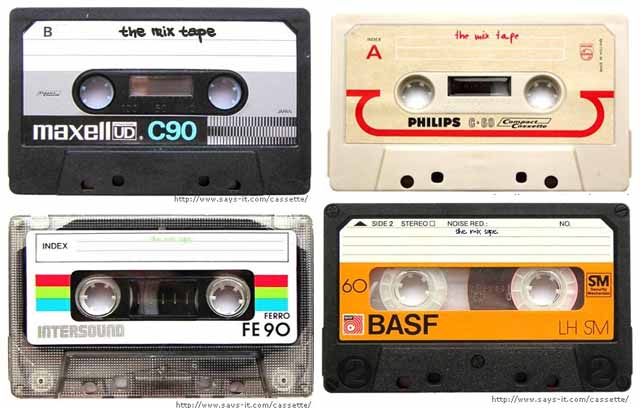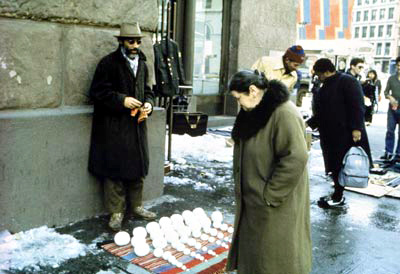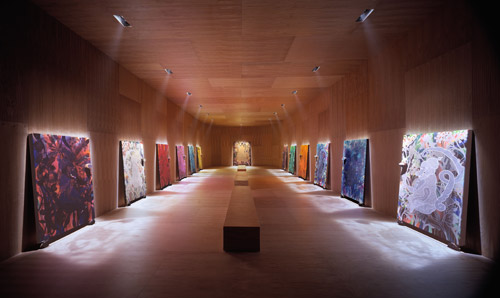
Making mixtapes is one of life’s great non-transferable skills; its lack of import in a pragmatic sense is inversely proportional to the amount of time and effort it requires (rewinding, pausing, forwarding, finding the exact moment the fade-out stops, designing the case – not too glib, not too earnest – and gouging out the square flaps at the top of the tape with a biro nib, so its permanence, and the permanence of the tape-maker’s affections in the mind of the listener, is assured). Mixtapes are tiny monuments of personal authority carried out by those usually lacking it in every other sphere. (It’s got to be a cassette, too: none of this CD business, skipping along at will and missing the carefully calibrated theme — usually a guarded and self-deprecatory expression of adoration for the listener.) I’ve often wondered where those specific and hard-won skills end up, whether they’re transmuted into filing techniques or the arrangement of ties in a wardrobe, or if they dwindle and diminish like an evolutionary cul-de-sac.
It seems increasingly obvious, though, that the mixtape maker’s most evident successor is the curator of works of art. Skip a room or walk through in the wrong order and you’re in danger of missing the theme entirely, and the curators will slam their bedroom doors and crank up The Cure so loud you can’t hear them cry. Admire one of the works and they’ll hum with misappropriated pride.
The new Chris Ofili mid-career retrospective at Tate Britain feels like walking through a mixtape of semi-obscure black American music from the last 50 years, created by a middle-aged record shop owner with an encyclopedic knowledge of musical history and a body odor problem. Arranged in a reverent chronology of the artist’s work – despite sidestepping his hilarious caganer-style defecating Rastafarian sculptures from a few years back – the show not only reveals Ofili’s indebtedness to musical history as a resource, but shows how deeply he’s absorbed it, providing visual equivalence for all manner of forms and themes in the musical past. In the interests of elucidation, then, and to provide to amateur mixtape-makers with a set of guidelines in producing their own audio tour of the show, I have put together a rough soundtrack according to the different phases of the artist’s career. Please pay attention.

David Hammons, "Bliz-aard Ball Sale" (1983)
The first room of the exhibition shows Ofili’s early, heavily David Hammons-inspired work (where are the Hammons retrospectives, by the way, Triple Candie Xerox show notwithstanding?), which introduces principle themes the artist returns to, like a tongue to a bad tooth. Shithead – a ball of dried elephant dung from Whipsnade Zoo, with human teeth and the artist’s trimmed dreads set into it – introduces (via its evident ape-ing of then-established Hammons tropes) Ofili’s major ongoing interest in the mutual attrition of the spiritual and the profane. The Rastafarian reference (Ofili was raised Catholic to Nigerian parents in Manchester, and wore dreadlocks as a student) is as lightly held as any other in the first phase of Ofili’s work. It is preoccupied with the collision of visual information, both laterally (information spreads in clusters across the large canvases, propped against the wall) and in the geological layers of their surfaces (glitter, resin, paint, collage; the material descriptions of the wall labels read like an inventory of Elton John’s costume cupboard). The spacey intricacies of these early works – Spaceshit, Popcorn Tits, and the William Blake-referencing 7 Bitches Tossing Their Pussies Before the Divine Dung – recall magic eye posters of the early nineties as much as their purported origin in African cave painting and Aboriginal Australian art. Their intergalactic obsessions, and fascination with scatology and wild sensuality, finds appropriate sonic form in George Clinton’s varied musical oeuvre, and for this room, the show’s first, the track is Funkadelic’s “Promentalshitbackwashpsychosis Enema Squad (The Doodoo Chasers).”
Room 2 is Ofili in provocative, all-or-nothing mode during the mid-to-late 90s, the Ofili of Sensation and the YBAs: the Giuliani-baiting Holy Virgin Mary, with its beaver-shot putti, the smiley-faced cartoon penis Pimpin’ Ain’t Easy, his lush and lustrous portraits of prostitutes (Foxy Roxy and Blossom) working near his studio in King’s Cross. Musicians’ names appear, dotted in map pins on clods of dung – Chaka Khan, LL Cool J, James Brown – but the prevailing musical analogy seems to be that of early to mid-90s rap, especially in its, um, complex attitude towards women. The golden age of early 90s sample-heavy hip-hop (this before litigious record companies got wind of its free-for-all purloining of their back catalogues) finds its visual parallel in works like Afrodizzia (1996), which could be an alternative album cover for the Jungle Brothers’ Done by the Forces of Nature (1989), a similarly dense and allusive collage of black history, formal exuberance and silly gags. And in Ofili’s No Woman, No Cry (1998) – a rich, strange and beautiful tribute to the mother of the murdered teenager Stephen Lawrence – there’s the same blend of delicate, soulful melancholy and disjointed, aggressive energy as Wu-Tang Clan’s “Tearz” (1993).

Chris Ofili and David Adjaye, "The Upper Room" (2002)
Ofili’s The Upper Room – an installation of thirteen paintings produced in collaboration with architect David Adjaye – is presented with the same kind of hushed reverence as Rothko’s Seagram murals (made for this building, but now housed in Tate Modern). Entering a long, floor-lit wooden corridor, you turn the corner to see twelve spotlit paintings of profiled rhesus monkeys, propped on dung against the wall, with one larger painting of a forward-facing chief monkey at the far wall. The Upper Room is full of delicious, candy-striped paintings with slicks of resin and glitter like sugary coatings, but the Last Supper allusion, and their This-Is-A-Masterpiece presentation by Adjaye, leaves little imaginative elbow room for the viewer. The disjointed cobbled-together quality of the previous work is more satisfying in comparison, providing a bit of visual grit to irritate the eye into looking closer. The earnestness, formal control and ambition of The Upper Room is redolent of inaccessibly virtuosic jazz — appealing in the abstract, but glimmeringly unrequiring of individual attention, like a book you feel you ought to read. For this room, then: Alice Coltrane’s “Blue Nile” (you’ll start fast-forwarding through this one).
Much better are Ofili’s works shown at the Venice Biennale in 2003, again installed in collaboration with Adjaye. Restricting themselves formally to the red, black, and green of Marcus Garvey’s pan-African flag, and thematically to a relationship between an afro’d and besuited man and a voluptuous, sometimes vampiric woman, they introduce a heady Caribbean atmosphere that became dominant in his work after his move to Trinidad in 2005. This sensuality and flirtation with formalized romantic encounters, as well as the allusion to Garvey, leads almost inevitably to the next track on the tape. A bit of lovers’ rock for good measure: Gregory Isaacs’ “Night Nurse.”
Ofili’s works on paper – watercolors and pencil drawings, some of which were shown at the Afromuses show at the Studio Museum in Harlem in 2005 – take up one of the penultimate rooms of the exhibition, and continue the romantic thread initiated in the Venice works. Here, overt sensuality has replaced the sometimes chaste formality of the Garvey-inspired paintings, in the form of Matissean nudes made up of hundreds of tiny drawn afro’d heads, or painted in rich, dark browns with bright specks of jewellery. These women – spilling over the edges of the paper, their bodies’ logic sublimated to their desire to be desired; they’re deboned, somehow – are the mirror opposite to the dayglo encrustations of the Kings Cross paintings. For this room, Minnie Riperton’s quite naughty “Inside My Love.”

Left: "The Raising of Lazarus" (2007). Right: "The Holy Virgin Mary" (1996)
The last couple of rooms bring the viewer up-to-date with Ofili’s most recent work, which, despite its absence of elephant dung supports – Ben Luke in the Evening Standard beat me to the ‘Ofili’s cut the crap’ pun, damn him – returns to something of the psychedelic loopiness of his earlier work. Drawing on Biblical narratives – Judas’ suicide, the Raising of Lazarus – as well as native Trinidadian folklore and the lush, airy atmosphere of the island itself, his work of the last few years has shed the horror vacui sedimentation associated with the artist. The painting-as-sculpture obstinacy of those early works, activating a triangular slice of gallery space between wall and floor, looking and standing, has been replaced by a Fauvist palette and melting line that flirts with Caribbean kitsch, like the walls of a themed restaurant. And yet there’s a strange, eschatological doominess to these paintings, despite their high-key palette; there’s a quality of the apocalyptic vision, sun-blasted and flicked with the shadows of trees. Hence the final track: Culture’s “Black Starliner Must Come,” from their 1977 album Two Sevens Clash.




Pingback: Greatest Hits: The Tate Britain Chris Ofili Retrospective as a Mixtape « MUSEYON GUIDES
Pingback: What’s Cookin at the Art21 Blog: A Weekly Index | Art21 Blog
Pingback: Reminder! « Accordions and Lace
Pingback: Letter from London: In the Loop | Art21 Blog